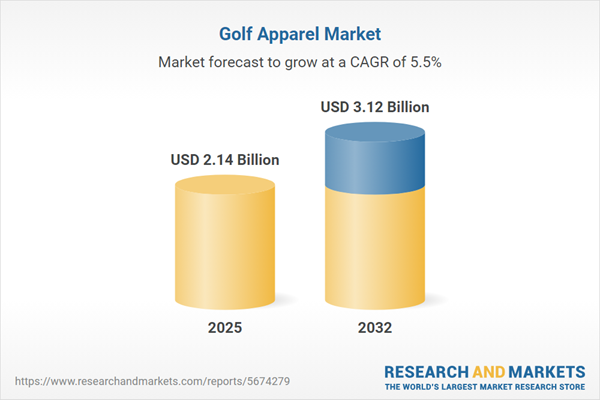Speak directly to the analyst to clarify any post sales queries you may have.
The golf apparel market is rapidly evolving to meet emerging consumer expectations, digital transformation, and sustainability priorities. Senior decision-makers face pivotal choices as they look to capitalize on changing preferences and technological advancements within this dynamic sector.
Market Snapshot: Golf Apparel Market Size and Growth
The global golf apparel market is projected to grow from USD 2.02 billion in 2024 to USD 2.14 billion in 2025, reaching USD 3.12 billion by 2032 at a compound annual growth rate (CAGR) of 5.54%. This expansion is fueled by increased participation in golf across varied demographics, continuous enhancements in fabric technologies, and a strong shift toward digital and omnichannel retail. Market leaders who align their strategies with innovation and omnichannel presence are well-positioned for sustainable competitive advantage as this sector undergoes transformation.
Scope & Segmentation
This report provides a comprehensive framework for assessing the golf apparel market, aiding leadership teams as they refine portfolio strategies and seize emerging opportunities. Segmentation covers:
- Product Types: Bags, gloves, hats, bottoms, outerwear, tops, and footwear—all designed to address performance, comfort, and evolving fashion requirements. Product diversity is critical in supporting functional needs and responding swiftly to consumer style preferences.
- Gender: Solutions catering to men, women, and kids, enabling brands to promote size inclusivity and address specific design considerations that expand access across all customer groups.
- Distribution Channels: Department stores, specialty sports retailers, brands’ digital platforms, direct-to-consumer strategies, mobile applications, and third-party retail partners. The integration of multiple channels equips brands to flexibly reach and engage customers online and offline.
- Age Groups: Dedicated offerings for adults, juniors, and children, supporting lifecycle-based product roadmaps and tailored marketing initiatives for different age segments.
- Regions: Americas, Europe, Middle East and Africa, and Asia-Pacific. Each region provides distinct demand drivers, regulatory factors, and consumer behaviors, supporting risk mitigation and local optimization.
- Leading Companies: Nike, Adidas, Under Armour, PUMA, Lululemon, Ralph Lauren, Callaway Golf, Acushnet, Mizuno, and ASICS. These organizations set benchmarks in innovation and differentiation strategies, frequently leveraging collaborations and technology to stay ahead in the global landscape.
Key Takeaways for Senior Executives
- Embracing advanced product features and transparent supply chains addresses the growing emphasis on sustainability and strengthens customer loyalty over the long term.
- Investment in virtual fitting tools and interactive digital platforms offers a pathway to reduce online returns while improving the customer experience during the purchasing process.
- Introducing sustainable design approaches and responsible sourcing practices aligns with rising consumer expectations and helps protect brand reputation across global markets.
- Expanding inclusive product design, especially for underrepresented consumer segments like women and younger golfers, supports portfolio growth and encourages innovation.
- Asia-Pacific and African markets offer significant opportunities for expansion due to evolving consumer profiles and technology adoption, representing gateways for new market entrants.
- Fostering collaboration between design, sourcing, and operations teams allows for a more agile and adaptive approach, improving the ability to anticipate and respond quickly to regulatory shifts or consumer trends.
Tariff Impact: Supply Chain Adaptation in the Golf Apparel Market
Recent shifts in US tariff policy have influenced the sourcing landscape for golf apparel. Major brands are diversifying supplier networks and considering more localized production models. These moves support cost management and offer enhanced flexibility to adjust to changing trade rules and market requirements, securing resilient and efficient supply chain operations.
Methodology & Data Sources
Research insights draw upon primary interviews with industry executives, thorough analysis of supply chain models, and benchmarking exercises. The report synthesizes information from government data, trade publications, and technical sources, utilizing advanced scenario modeling and visualizations to underpin strategic recommendations with robust, data-driven support.
Why This Report Matters
- Enables executive decision-making by offering focused analysis of emerging trends and potential market headwinds, empowering organizations to make informed investments and mitigate risk.
- Supports the development of customer-focused, sustainable, and technologically advanced business models for improved stakeholder engagement.
- Supplies actionable intelligence and scenario-based insights that help organizations anticipate change, ensuring a fortified approach to long-term sector participation.
Conclusion
This report serves as a vital strategic tool for executives guiding their organizations through the complex golf apparel landscape. The actionable insights provided facilitate leadership, operational alignment, and innovation readiness within a changing market environment.
Additional Product Information:
- Purchase of this report includes 1 year online access with quarterly updates.
- This report can be updated on request. Please contact our Customer Experience team using the Ask a Question widget on our website.
Table of Contents
3. Executive Summary
4. Market Overview
7. Cumulative Impact of Artificial Intelligence 2025
List of Figures
Samples

LOADING...
Companies Mentioned
The key companies profiled in this Golf Apparel market report include:- Nike, Inc.
- Adidas AG
- Under Armour, Inc.
- PUMA SE
- Lululemon Athletica Inc.
- Ralph Lauren Corporation
- Callaway Golf Company
- Acushnet Holdings Corp
- Mizuno Corporation
- ASICS Corporation
Table Information
| Report Attribute | Details |
|---|---|
| No. of Pages | 190 |
| Published | October 2025 |
| Forecast Period | 2025 - 2032 |
| Estimated Market Value ( USD | $ 2.14 Billion |
| Forecasted Market Value ( USD | $ 3.12 Billion |
| Compound Annual Growth Rate | 5.5% |
| Regions Covered | Global |
| No. of Companies Mentioned | 11 |









